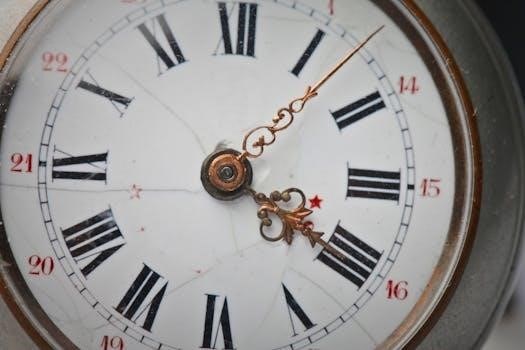Antique Clock Identification
Antique clock identification is an exciting puzzle for collectors to solve, involving determining the clock’s age and maker․ Clocks often have maker’s marks on the dial or back plate․ This process is crucial for authentication and understanding the clock’s history․
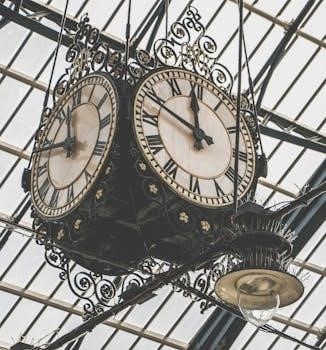
Identifying Clock Types
Identifying antique clock types is the first step in understanding their history and value․ Common types include grandfather clocks, which are tall, freestanding clocks encased in wooden boxes, often made from oak or mahogany․ Mantel clocks are smaller and designed to sit on a shelf or fireplace mantel, often adding a decorative touch to a room․ Wall clocks are designed to be mounted on a wall and come in various styles, such as regulator clocks, which are known for their accuracy․ There are also carriage clocks, which are portable and typically have a handle․ Each type of clock has its own unique characteristics and materials, which can help in the identification process․ Recognizing these different types is essential for collectors and enthusiasts alike, as it lays the groundwork for further research and valuation․ Understanding the specific features of each type will help to narrow down potential origins and time periods of manufacture․
Clockmaker’s Marks and Insignias
Clockmaker’s marks and insignias are crucial for identifying antique clocks, often providing a direct link to the manufacturer and time period․ These marks can be found in various places, such as the clock’s dial, backplate, or movement․ They may include the clockmaker’s name, initials, or a unique symbol․ Sometimes, foreign clockmakers used only initials or trademarks, making identification more challenging․ Consulting reference books, online databases, or horological trade mark indices can help decipher these markings․ The presence of a trademark or insignia can often confirm the authenticity of an antique clock․ It is important to note that some clockmakers’ marks may be very subtle, requiring careful inspection․ Understanding the different styles of markings used across time periods can greatly aid in identifying the origin and age of the clock․ Recognizing these subtle details is a key skill for any antique clock enthusiast․
Location of Identification Marks
The location of identification marks on an antique clock varies, but understanding common placements is vital for identification․ Often, the clockmaker’s name, initials, or logo can be found engraved or printed near the center of the dial․ Alternatively, these marks may appear around the dial’s edge․ The backplate of the clock movement is another common location, often on the lower right side, where numbers or insignias are inscribed․ Some American clocks might have identification details on the front plate, which is less common than markings on the back․ It is also worth inspecting the inner workings of the clock, as some manufacturers marked parts of the movement․ The case itself, specifically the back or the base, may also carry less obvious marks․ When examining a clock, you must be thorough, checking all possible locations for any markings, as these subtle clues are essential for accurate identification․ The meticulous search for these marks is a key aspect of antique clock study․
Importance of Movement Numbers
Movement numbers on antique clocks are crucial for identification and often provide valuable insights into the timepiece’s history․ Typically located on the backplate of the movement, these numbers can help determine the manufacturer, production date, and even the specific batch the clock was made in․ These are not always serial numbers in the modern sense, but they can be part of a sequence used by the maker for quality control or inventory purposes․ Comparing these numbers against databases, resources, or horological archives can reveal the clock’s origins, especially if the maker’s name or logo is not prominently displayed․ They are essential in tracing lineage, and sometimes, they are the only unique identifier that separates one clock from another identical model․ Therefore, movement numbers are a key aspect in authenticating and assessing antique clocks, and should never be disregarded when trying to understand your timepiece․ These numbers are invaluable for researchers, collectors, and anyone trying to trace the story of an old clock․
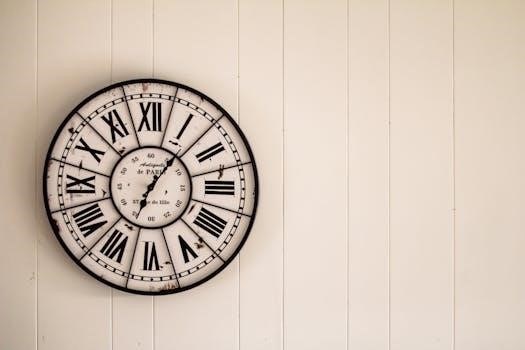
Antique Clock Price Guide
Determining the value of an antique clock involves various factors, including its type, condition, maker, and rarity․ Online resources and antique dealers can provide estimates, but understanding these factors is key to assessing a clock’s true worth․
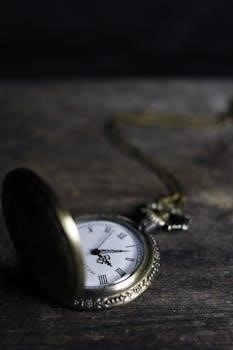
Factors Influencing Clock Value
Several elements contribute to an antique clock’s price, beginning with its rarity and age․ Older clocks, particularly those from renowned makers, often command higher prices․ The type of clock, such as a grandfather, mantel, or wall clock, also affects value, with some designs being more sought after than others․ The materials used in construction, like oak, mahogany, or specific metals, can also significantly influence the price․
The clock’s condition is paramount; a well-preserved clock with original parts is more valuable than one needing restoration․ The presence of maker’s marks or insignias further boosts worth, authenticating the clock’s origin and potentially increasing its historical value․ Finally, the overall aesthetic appeal and the intricacy of the clock’s design play a role in determining its market price․ Unique features or decorative elements may enhance its desirability among collectors, leading to a higher valuation; The demand for a particular style or maker during a given time can also affect the price․
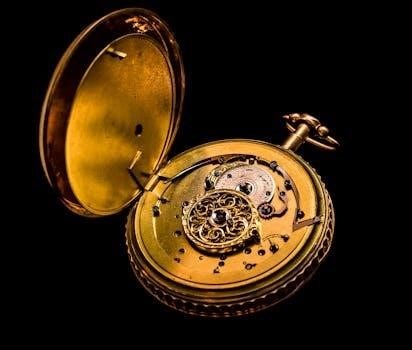
Using Online Resources for Price Estimates
The internet provides a wealth of resources for estimating the value of antique clocks․ Online databases and price guides, such as those found on specialized antique websites or auction house archives, can offer valuable insights․ These platforms often contain records of past sales, allowing you to compare your clock to similar pieces․ Collectors’ forums and online communities can also be beneficial, providing access to the knowledge and experience of fellow enthusiasts․
However, it is essential to be critical of online information, as the accuracy of pricing can vary; Consider multiple sources and compare estimates to get a comprehensive view․ Some websites might require paid subscriptions for detailed access, which could be a worthwhile investment for serious collectors․ Be aware that online estimates should be considered as guidelines, not definitive values, as the clock’s actual price will still depend on factors like condition and demand․ Finally, remember to cross-reference information from various sites to ensure a more accurate estimate․
Consulting Antique Dealers
Seeking the expertise of reputable antique dealers is a crucial step in determining the value of your antique clock․ Dealers, with their extensive experience and knowledge, can provide accurate appraisals, taking into account various factors such as the clock’s age, maker, condition, and current market trends․ They possess a deep understanding of the nuances of the antique clock market that online resources might not capture․ A dealer can also authenticate your clock, identifying potential reproductions or forgeries․
Furthermore, a good dealer can offer insights into the clock’s history and significance․ They may also provide advice on restoration or maintenance to preserve its value․ When selecting a dealer, look for one who specializes in antique clocks and has a strong reputation within the community․ Don’t hesitate to ask about their experience and qualifications․ While they may charge a fee for their services, the accurate valuation and insights they provide are often well worth the investment․ Remember that their expertise is invaluable for understanding the true worth of your timepiece․
Understanding Clock Condition
The condition of an antique clock significantly impacts its value and desirability․ A clock in excellent original condition, with all its parts intact and functioning correctly, will command a higher price․ Conversely, clocks with damage, missing components, or extensive repairs will have a lower value․ Assessing condition involves examining the case, dial, hands, movement, and any decorative elements․ Look for cracks, chips, fading, or warping in the case material, whether it’s wood, metal, or other materials․ Check if the dial is original, free from damage, and legible․ The hands should be the correct style and material for the clock’s age․
The clock’s movement must be inspected closely for wear, damage, or replaced parts․ Note any signs of rust, corrosion, or previous repairs that could affect its functionality․ The presence of original parts is highly desirable, as replaced parts can diminish the clock’s authenticity and value․ Understanding these aspects will allow you to accurately evaluate the condition of an antique clock and determine its potential value․ Always be thorough and critical when assessing the condition․
Recognizing Reproduction Clocks
Identifying reproduction antique clocks is crucial to avoid overpaying or being misled․ Modern reproductions often mimic the style of antique clocks, but subtle differences can help distinguish them․ Examine the clock carefully for signs of age, such as wear and patina․ Reproduction clocks may have a flawless, almost new appearance, which is not typical of genuine antiques․ The materials used can also be a clue; reproductions may use modern materials that were not available when the original clocks were made․ Pay attention to the quality of construction, as reproduction clocks often lack the craftsmanship found in authentic antique pieces․ Check the movement for modern components and signs of mass production․
Look for inconsistencies or anachronisms in the design․ The presence of very clear, modern lettering or markings that do not correspond to any known clockmakers can also indicate a reproduction․ Always be cautious of clocks offered at prices that seem too good to be true․ It is essential to research and compare before making a purchase․ Familiarize yourself with the characteristics of authentic antique clocks to better identify potential reproductions․
